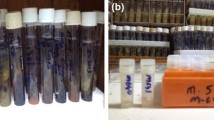Abstract
Five nonsynnematous and six synnematous isolates of the acaropathogenic fungus Hirsutella thompsonii were successfully stored as mycelial beads in sterile water under refrigeration. They were viable for up to 96 months without any adverse effect on their pleomorphic characteristics. Besides, there was loss neither in pathogenicity nor in genetic purity. Thus, mycelial beads can now be an addition to the list of fungal propagules that are amenable to storage in sterile water over a long period.




Similar content being viewed by others
References
Boeswinkel HJ (1976) Storage of fungal cultures in water. Trans Br Mycol Soc 66:183–185
Castellani A (1939) Viability of some pathogenic fungi in distilled water. J Trop Med Hyg 42:225–226
Castellani A (1967) Maintenance and cultivation of common pathogenic fungi of man in sterile distilled water, further researches. J Trop Med Hyg 70:181–184
Clark G, Dick MW (1974) Long-term storage and viability of aquatic Oomycetes. Trans Br Mycol Soc 63:611–612
Ellis JJ (1979) Preserving fungus strains in sterile water. Mycologia 71:1072–1075
Figueiredo MB (1967) Estudes sobre a aplicação de Castellani para conservação de fungos patógenos em plantas. O Biológico 33:9–15
Figueiredo MB, Pimentel CPV (1975) Métodos utilizados para conservação de fungos na micoteca de seção de Micologia Fitopatológica de Instituto Biológica. Summa Phytopathol 1:299–302
Glasel JA (1995) Validity of nucleic acid purities monitored by 260 nm/280 nm absorbance ratios. BioTechniques 18:62–63
Hajek AE, Humber RA, Griggs MH (1990) Decline in virulence of Entomophaga maimaiga (Zygomycetes: Entomophthorales) with repeated in vitro subculture. J Invertebr Pathol 56:91–97
Hajek AE, Shimazu M, Humber RA (1995) Instability in pathogenicity of Entomophaga maimaiga after long-term cryopreservation. Mycologia 87:483–489
Hartung de Capriles C, Mata S, Middelveen M (1989) Preservation of fungi in water (Castellani): 20 years. Mycopathologia 106:73–80
Humber RA (1997) Fungi: preservation of cultures. In: Lacey LA (ed) Manual of techniques in insect pathology. Academic, London, pp 269–280
López Lastra CC, Hajek EA, Humber RA (2002) Comparing methods of preservation for cultures of entomopathogenic fungi. Can J Bot 80:1126–1130
Marx DH, Daniel WJ (1976) Maintaining cultures of ectomycorrhizal and plant pathogenic fungi in sterile water cold storage. Can J Microbiol 22:338–341
McCoy CW, Hill AJ, Kanavel RF (1972) A liquid medium for the large-scale production of Hirsutella thompsonii in submerged culture. J Invertebr Pathol 19:370–374
Onions AHS, Smith D (1984) Current status of culture preservation and technology. In: Batra LR, Iigima T (eds) Critical problems of culture collections. Institute of Fermentation, Osaka, pp 41–47
Samson RA, McCoy CW, O’Donnell KL (1980) Taxonomy of the acarine parasite Hirsutella thompsonii. Mycologia 72:359–377
Smith D, Onions AHS (1994) The preservation and maintenance of living fungi. In: IMI technical handbooks no. 2, 2nd edn. International Mycological Institute, CAB International, Egham
Sreerama Kumar P, Singh L (2008) Enabling mycelial application of Hirsutella thompsonii for managing the coconut mite. Exp Appl Acarol 46:169–182
Talbot NJ (2001) Nucleic acid isolation and analysis. In: Talbot NJ (ed) Molecular and cellular biology of filamentous fungi: a practical approach. Oxford University Press Inc., New York, pp 23–32
Acknowledgment
The authors immensely thank Dr. Richard A. Humber, Insect Mycologist and Curator, USDA-ARS Collection of Entomopathogenic Fungal Cultures, USDA-ARS Biological Integrated Pest Management Research Unit, Robert W. Holley Center for Agriculture and Health, Ithaca, NY 14853, USA, for the pre-submission review and useful comments on the manuscript.
Author information
Authors and Affiliations
Corresponding author
Rights and permissions
About this article
Cite this article
Sreerama Kumar, P., Singh, L. A simple method of storing nonsynnematous and synnematous isolates of Hirsutella thompsonii while conserving their pleomorphism, pathogenicity and genetic purity. Folia Microbiol 57, 15–19 (2012). https://doi.org/10.1007/s12223-011-0087-0
Received:
Accepted:
Published:
Issue Date:
DOI: https://doi.org/10.1007/s12223-011-0087-0




